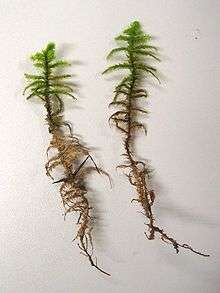Rhytidiadelphus triquetrus
Rhytidiadelphus triquetrus, the big shaggy-moss[1] or rough goose neck moss,[2] is species of moss in the family Hylocomiaceae. It is often the dominating moss species in moderately rich forest habitats in the boreal regions and the Pacific Northwest. Because of its fuzzy appearance and tail-like shape it is also called the 'electrified cat's tail moss'.[3] Not to be confused with square goose-necked moss, Rhytidiadelphus squarrosus.
| Rough goose neck moss | |
|---|---|
 | |
| Scientific classification | |
| Kingdom: | Plantae |
| Division: | Bryophyta |
| Class: | Bryopsida |
| Subclass: | Bryidae |
| Order: | Hypnales |
| Family: | Hylocomiaceae |
| Genus: | Rhytidiadelphus |
| Species: | R. triquetrus |
| Binomial name | |
| Rhytidiadelphus triquetrus | |
Ecology
Terrestrial on humus-rich substrates in montane forests. Occasionally grows on logs and trees in lowland rainforests or on sandy-gravelly soils near streams.[3]
gollark: What? Do you have an archived copy of that?
gollark: Check the headers?
gollark: Exactly. So by the idea of the veil of ignorance, it's ethical for us to log all things ever too!
gollark: I'm sure Discord logs everything ever permanently themselves.
gollark: It runs OIR now playing stuff, an IRC bot for some reason, and also a small youtube-dl frontend and some minor potatOS services.
References
- Edwards, Sean R. (2012). English Names for British Bryophytes. British Bryological Society Special Volume. 5 (4 ed.). Wootton, Northampton: British Bryological Society. ISBN 978-0-9561310-2-7. ISSN 0268-8034.
- "Rhytidiadelphus triquestrus". Natural Resources Conservation Service PLANTS Database. USDA. Retrieved 22 October 2015.
- Pojar, Jim; Mackinon, Andy. Plants of the Pacific Northwest Coast. Lone Pine.
External links
- Rhytidiadelphus triquetrus in the Bryophyte Flora of North America


This article is issued from Wikipedia. The text is licensed under Creative Commons - Attribution - Sharealike. Additional terms may apply for the media files.